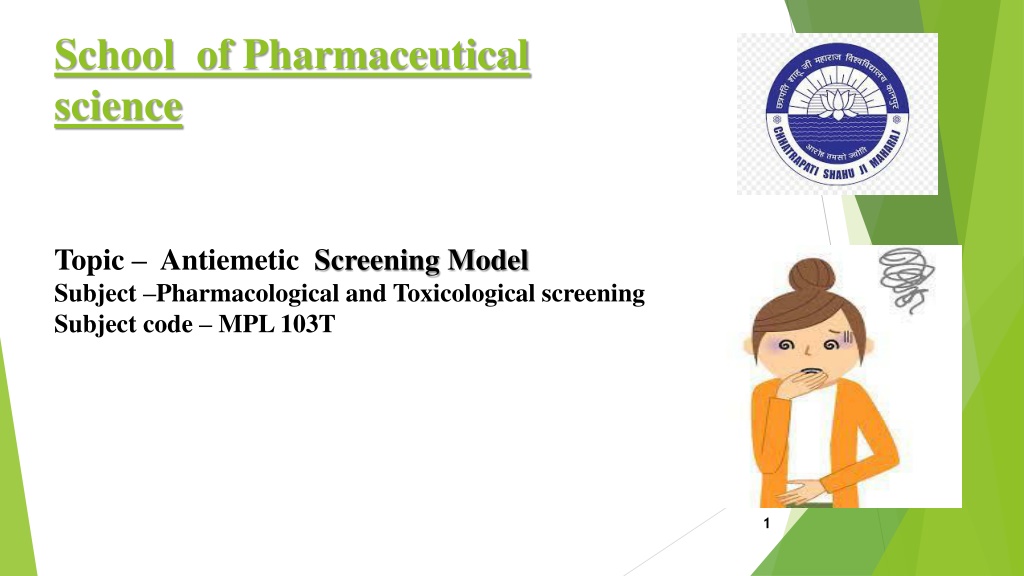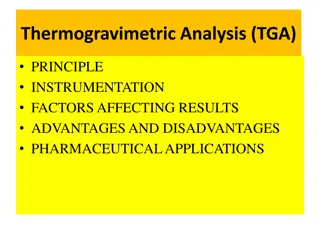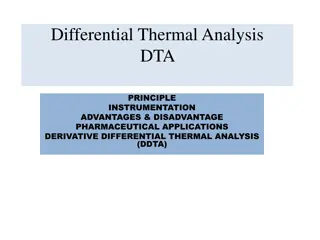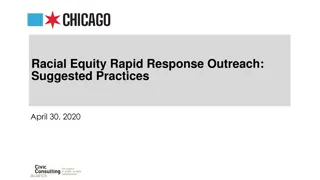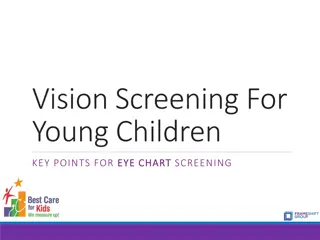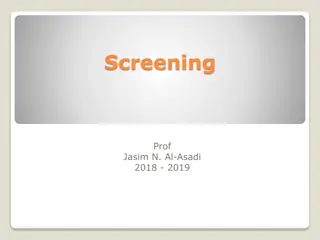Understanding Antiemetic Screening Models in Pharmaceutical Science
Explore the fascinating world of antiemetic screening models in pharmaceutical science, covering topics such as the pathogenesis of vomiting, choice of emetogens, commonly used animals, parameters assessed, screening models, and more. Learn about drug-induced emesis models and the critical parameters evaluated in pharmacological and toxicological screening. Dive into the complexities of nausea, emesis, retching, and ejection processes, along with the cerebral cortex and chemoreceptor-triggered zones involved in vomiting.
Download Presentation

Please find below an Image/Link to download the presentation.
The content on the website is provided AS IS for your information and personal use only. It may not be sold, licensed, or shared on other websites without obtaining consent from the author. Download presentation by click this link. If you encounter any issues during the download, it is possible that the publisher has removed the file from their server.
E N D
Presentation Transcript
School of Pharmaceutical science Topic Antiemetic Screening Model Subject Pharmacological and Toxicological screening Subject code MPL 103T 1
V CONTENTS Introduction Pathogenesis of vomiting Choice of animals and Emetogens Parameters observed In vivo models In vitro model Human model References @2022 AAROHI TIWARI 2
INTRODUCTION Nausea: Non observable subjective feeling of having the urge to vomit. EMESIS: 1. ACUTE EMESIS: Occurs within minutes and resolves within 24 h. 2.DELAYED EMESIS: Occurs after 2-3 days . 3.BREAKTHROUGH EMESIS: Emesis occurring after the prophylactic antiemetic treatment . RETCHING: Attempt to vomit without expulsion of vomitus. EJECTION: Expulsion of vomitus forcefully through mouth and nose. @2022 AAROHI TIWARI 3
PATHOGENESIS Cerebral Cortex Cancer Chemotherapy Chemoreceptor Triggered Zone (CTZ) VOMITING CENTRE (MEDULLA) Vestibular nuclei Pharynx and GIT @2022 AAROHI TIWARI 4
COMMONLY USED ANIMALS Animals are normally used . Commonly used animals : Dogs 1. Cats 2. Ferrets 3. Monkeys 4. Gerbils 5. @2022 AAROHI TIWARI 5
CHOICE OF EMETOGENS Drug Induced 1. Radiation Stimulus 2. Motion Stimulus 3. @2022 AAROHI TIWARI 6
Parameter Assessed Behavioral changes. Latency to first retching and vomiting. Number of vomiting episodes. Conditional flavor avoidance (PICA) in mice. @2022 AAROHI TIWARI 7
SCREENING MODEL Drug-induce emesis model Apomorphine-induced emesis model Copper sulfate-induced emesis model Motion-induced emesis model Radiation-induced emesis model @2022 AAROHI TIWARI 8
DRUG INDUCED EMETIC MODEL Cisplatin-induced emesis model Apomorphine-induced emesis model CusSo4-induced emesis model Methotrexate-induced emesis model @2022 AAROHI TIWARI 9
CISPLATIN INDUCED DOG MODEL Described by Gylyl et al. Used to evaluate antiemetic properties of 5-HT3 receptor antagonists. TEST GROUP Test drug is administered . 10 min later ,Cisplatin is administered IV at a dose of 3.2mg/kg/ml. OBSERVATIO N FOR 5 HOURS Dogs with no obvious toxicity are retested after an interval of 4 weeks. CONTROL GROUP Vehicle is administered .10 min later ,Cisplatin is administered IV at a dose of 3.2 mg /kg/ml. @2022 AAROHI TIWARI 10
CISPLATIN INDUCED CAT MODEL Cats of either sex can be used and they should be 2-6 kg. TEST GROUP Cisplatin is administered IV at a dose of 3-7.5 mg/kg/ml over 4m. Immediately after this ,test drug is administered . Observed for 4 hours for emetic episodes. CONTROL GROUP Cisplatin is administered IV at a dose of 3-7.5mg/kg/ml over 4 m . Immediately after this ,vehicle is administered. @2022 AAROHI TIWARI 11
CISPLATIN INDUCED FERRET MODEL Animals are subjected to overnight fasting . TEST GROUP Test drug and cisplatin (IV at a dose of 10mg/kg/ml) are administered . If test drug is given orally ,give Cisplatin 30 min later. Observation for 4 hours for emetic episodes CONTROL GROUP Vehicle and Cisplatin (IV at a dose of 10 mg/kg/ml)are administered . @2022 AAROHI TIWARI 12
Pigeon Model S.Murinus Model Mice Model 4mg/kg IV. 20 mg/kg IP. 3-10mg/kg IP. Duration between administration of drug/vehicle and cisplatin depends upon expected time of drug action . Duration between administration of drug/vehicle and cisplatin is 30 mins Cisplatin is administered 30 mins after rats have been pretreated with drug / vehicle . Observed for emetic episodes . Observed for 2hr for behavioural changes as well as emetic . Observable for pica (ingestion of non-food substances). @2022 AAROHI TIWARI 13
APOMORPHINE INDUCED EMESIS MODEL Dogs are most sensitive followed by Ferret. Use of Apomorphine in Cat is controversial as administration of Apomorphine can cause excitation in Cats. Suncus murinus is unresponsive to Apomorphine. @2022 AAROHI TIWARI 14
Dog Model Ferret Model Mice Model 0.3mg/kg SC 0.25mg/kg SC 10 mg/kg IP Duration between administration of drug and apomorphine depends upon expected time of drug action . Duration between administration of drug and apomorphine is 30 mins. Apomorphine is administered to mice pre treated with drug /vehicle. Observation for emetic episodes Observation for 60 mins for behavioural changes as well as emetic episodes Observe for pica( ingestion of non food substances ) @2022 AAROHI TIWARI 15
COPPER SULPHATE INDUCED EMESIS MODEL Powerful oxidizing agent. An irritant to mucosa membranes . If administered orally ,it causes irritation of gastric mucosa and leads to nousea and vomiting . Solvent: distilled water @2022 AAROHI TIWARI 16
Ferret method Sun murinus model Chick model 40mg /kg orally 40 mg/kg intragastric 50 mg/kg orally Drug /vehicle pretreated ferrets are administered CuSo4 . Duration between administration of drug and CuSo4 is 30 mins. Duration between admistration of drug and CuSo4 is 10 mins. Observed for latency and frequency of emetic episodes . Observed for 60 min for emetic episodes . Observation for latency and frequency of emetic episodes . @2022 AAROHI TIWARI 17
MOTION INDUCED EMESIS MODEL Commonly used for motion emesis drug model are: Cat model Suncus murinus model Mice model @2022 AAROHI TIWARI 18
Cat model Snucus murinus model Mice model Vertical oscillations at 0.3 Hz through a distance of 75 cm . Horizontal oscillations of 4 cm at 1Hz for 10 min 60 min double rotations Repetative licking , salivation often dripping out of mouth or vomiting . Emetic episodes are noted during motion during as well as motion cease . Increase kaolin intake indicates motion sickness . Increase latency/decrease frequency of emesis in cats pretreated with drug indicates antiemetic action. Animal can be exposed only twice in 1week adaptation to motion stimuli. Decrease kaolin intake in rats pretreated with drug indicates antiemetic action . @2022 AAROHI TIWARI 19
RADIATION INDUCED EMESIS MODEL Dog model Ferret model Mice model Ferret are most sensitive to radiation followed by dogs . Cats are resistant to radiation . @2022 AAROHI TIWARI 20
Dog model Ferret model Mice model Co60; 8Gy administration to total body surface Co 60; 201cGy 4Gy of total body irradiation One group gets drug and other group gets no medications. Emesis incidence of 100% is reported at 201 cGy in ferret. Exposure to radiation induces pica in mice . Increase latency / decrease frequency of emesis in cats pretreated with drug indicates antiemetic action . Increased latency / decreased frequency of emesis in cats pretreated with drug indicates antiemetic action. Decreased kaolin intake in mice pretreated with drug indicates antiemetic action . @2022 AAROHI TIWARI 21
IN VITRO MODEL 5-HT3 antagonist are the most potent of all antiemetic . The experimental drug can be evaluated for 5 HT3 receptor antagonist activity using in vitro animal model. Method Distal colon (20 mm) Krebs-Henseleit solution 2-methyl-5-HT(Agonist) Tropisetron (Antagonist) Temp:37 C Vol.(inner bath)10 ml @2022 AAROHI TIWARI 22
HUMAN MODEL Apomorphine Induced Apomorphine 0.05 mg/kg ,SC is an appropriate challenge dose for testing compounds for antiemetic activity in normal human volunteers. Frequency of emesis is checked. Ipecac Induced Healthy men are given single 5 minute infusions of ondansetron 30 min before oral administration of 30 ml syrup of ipecac . Emetic episodes and nousea are assessed over an 8 hr period. @2022 AAROHI TIWARI 23
REFERENCES H . Gerhard Vogel (Ed.)Drug Discovery and Evaluation Second edition. @2022 AAROHI TIWARI 24
